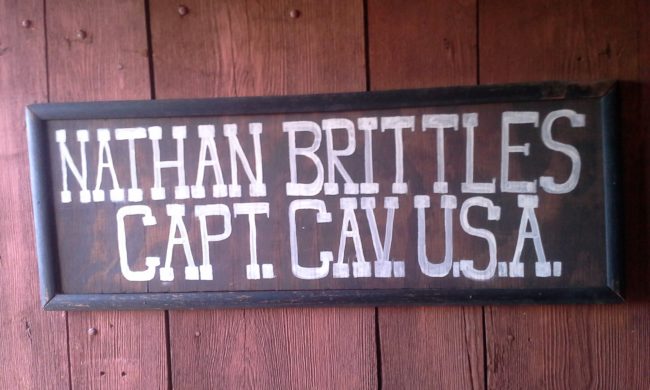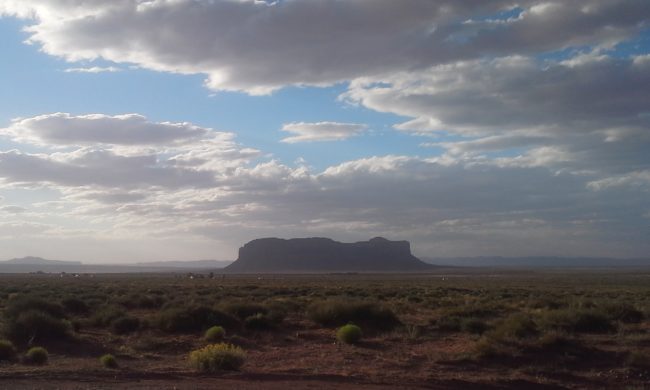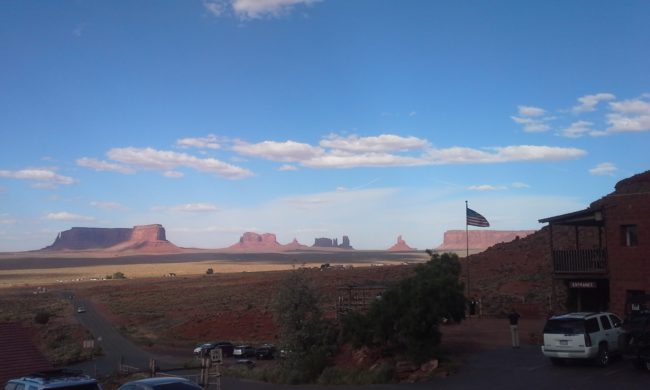 A few days in Monument Valley is not enough time to separate what the eye sees from what the movie eye remembers.
A few days in Monument Valley is not enough time to separate what the eye sees from what the movie eye remembers.
One would have to be Navajo or a white man like Harry Goulding who drove sheep here before WW I, and on his return bought 640 acres, a square mile, for $340, the only white man to own land in 1.7 million acres of the Navajo Rez. He saw this land when it was the most isolated spot in the continental US, 180 miles from a railhead, a full 24 hours journey to and from the nearest town of Bluff, Utah. He and his wife learned the language and built a trading post whose upstairs porch looks out over 30 miles of high desert and the most iconic formations in American culture. In 1938 John Ford shot Stagecoach here and this dot on the map filled the American public’s idea of what the American West looked like and how its conflicts between White and Red might have played out. Ford and Wayne created the myth that now both completes and obscures how we make sense of all this.
There are moments when the deeper reality breaks through. At the base of one of the buttes, the cliff face to a height of about 10 feet carries petroglyphs of six pronghorn antelope and beneath it, guarded by a flimsy 4 foot high chicken wire fence, Anasazi pottery shards with circles of blue, about 700 years old, untouched, for the Navajo believe to take them home would be to carry death into the house. 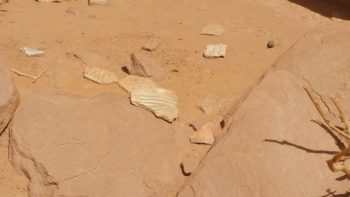
pottery shards found
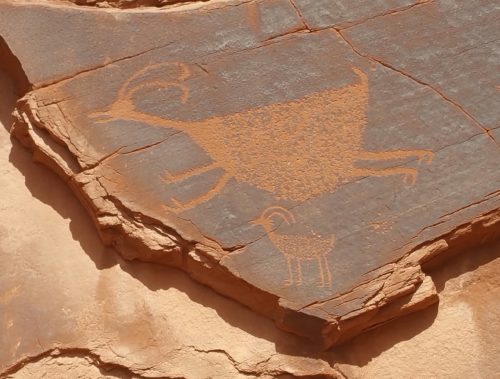 with these petroglyphs of antelope
with these petroglyphs of antelope
on this immense wall right where I am standing
Circling the buttes are small homes, a few with solar panels, each with a hogan, nine logs high, mud-encased with a central hole for the wood burner, its entrance always built due east to accept first light. Cattle dogs and horses wander without fences. The homes have no running water. Their pickup trucks are loaded with 1000 gallon tanks. They fill up at Gouldings. One woman I spoke to, a jeweler, a speaker still of the old tongue, said the last five years have been drier, the sand dunes incrementally higher; her grandfather said that when he was a boy, there was more vegetation, and the washes would often rise up with water for their sheep and horses.
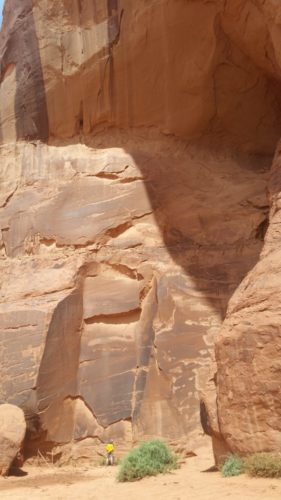 A weaver used a straight-up loom and at one time had taken her colors from yellow sweet cloves, blackberries, sumac leaves and scarlet bugler. She still keeps the design in her head and measures proportion by counting knots.
A weaver used a straight-up loom and at one time had taken her colors from yellow sweet cloves, blackberries, sumac leaves and scarlet bugler. She still keeps the design in her head and measures proportion by counting knots.
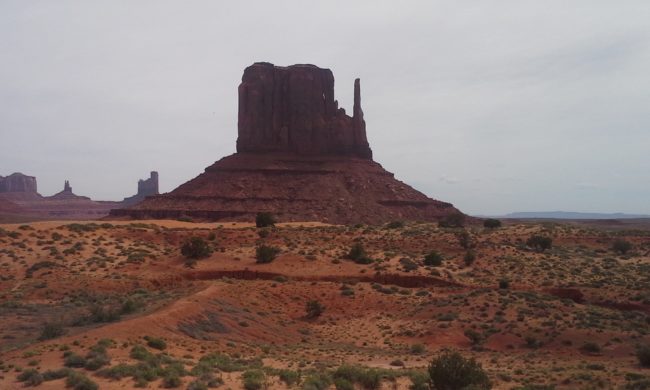 At West Mitten, Navajos selling jewelry wore bandanas to cover their mouths from the blowing red dust. An American flag folded a photo of Geronimo, a Chiricahua Apache, into the center of the stripes. For five dollars you could take a photo of a boy in a red shirt posing on his horse on an outcropping set against the vista. The horse turns round on that narrow rock like a pro. A young man in a Mormon-Eye t-shirt that said in huge letters “Only God Can Judge Me” carried wares from their pick-up to the table.
At West Mitten, Navajos selling jewelry wore bandanas to cover their mouths from the blowing red dust. An American flag folded a photo of Geronimo, a Chiricahua Apache, into the center of the stripes. For five dollars you could take a photo of a boy in a red shirt posing on his horse on an outcropping set against the vista. The horse turns round on that narrow rock like a pro. A young man in a Mormon-Eye t-shirt that said in huge letters “Only God Can Judge Me” carried wares from their pick-up to the table.
Lots of young Navajo men drive muscle cars, Mustangs especially, and on these straight roads, they move like land-rockets. On the drive in, for miles and miles, the passenger side verge was littered with thousands and thousands of beer and liquor bottles, smashed. No alcohol is available on the Rez. Each year fewer and fewer of the young keep up with the language, but in the deep back country there are some who speak only the original tongue, who live only in hogans and who keep to the old ways as best they can.
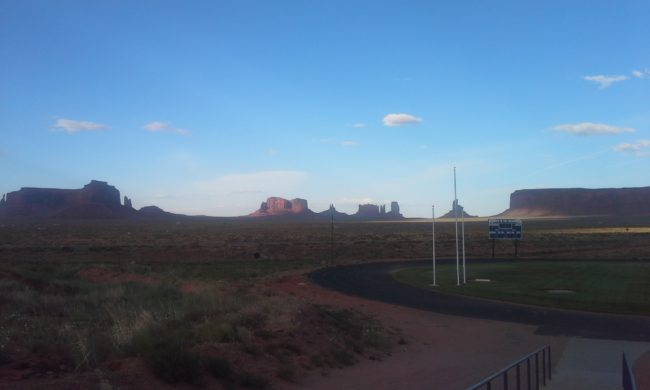 the view from the School parking lot overlooking the football field
the view from the School parking lot overlooking the football field
The Monument Valley School System has 400 students, K-12, and some still walk from their homes each day, taking short-cuts up and down some of the buttes, scrambling up rock faces as their parents and grandparents did before them.
We toured the back country with a Navajo guide, Anna, who claims over 500 in her extended family, and who spoke of traditional gatherings to celebrate a baby’s first giggles so that the child will grow up to be happy and generous. She had her tourist patter down. She directed our gaze to rocks shaped like “Snoopy” and “Elvis”, “a cat”, a “chair”, a “big hand.” But when pressed, she told us about Rain God Mesa where in the old times a shaman was lifted to its top by a cloud. He spent days dancing until his prayers were granted and rain fell until the washes were full and the People’s needs were met, and then the clouds would gently bring him back to the green earth.
A John Wayne movie is shown each night at Gouldings — Fort Apache, She Wore A Yellow Ribbon, The Searchers, etc., — all of them shot here. Every night. The Indians in the movies are Cheyenne or Comanche or Sioux, but Navajos earned good money in those days as extras. They did not care who they were supposed to be. A stoic, quiet, Navajo man runs the projector for the French, German, Chinese and American tourists who lean forward to look at Wayne severely arranged, posed, his face grown unforgettable, against this most American of panoramas.
a sign on an adobe cabin used for the exterior shot of Brittles’ quarters in She Wore A Yellow Ribbon
